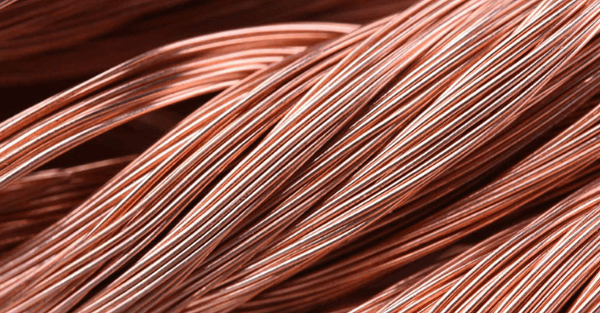Five intriguing facts about copper
Mining

Mining
Dubbed ‘the eternal metal’ for its 100 per cent recyclable properties, copper has been used by humans for millennia, and remains one of the most valuable metals on the market today. So, what makes it so enduring and special?
It’s no surprise copper ranks as the third most consumed metal in the world: our modern lives depend on it. Without copper, our world would be stuck at a tech level of the late 1800s – we would have very few cars, air travel would be near impossible, we’d have no phones, no radio and only mechanical computer machines.
This transition metal has many desirable properties which make it incredibly versatile: it is malleable, recyclable, ductile, highly durable, resists corrosion, and is an excellent conductor of heat and electricity. In your lifetime, copper is likely to support you in many ways – from your smartphone, the wiring in your solar panels and the plumbing in your house, to your electric toothbrush, your spare coins, your television and your electric car.
If you own a musical instrument, have a dental amalgam (filling), go for an ultrasound, or work with windfarm controls or rocket engines, you are likely to brush up against copper. It’s even likely you’ll rest in it after burial (a coffin) or cremation (an urn). Read on for five fascinating facts about this metal that you may not know.
While modern life leans heavily on copper, this metal is far from a fledgling when it comes to supporting humans. People have mined and worked with copper for at least 10,000 years, as evidenced by the 1991 discovery of Ötzi the glacier mummy in the Ötztal Alps (circa 3300 BCE), who sports a perfectly preserved axe consisting of 99.7 per cent pure copper. Further threads of copper use are woven throughout our history. It is understood that Neolithic communities used copper as an alternative to stone tools around 8,000 BC.
Ancient Egyptians believed copper was sacred and that it bestowed magical powers on its wearer. And the name ‘copper’ is said to come from the Romans, who called it ‘aes cyprium’ which translates to ‘ore from Cyprus’, as the majority of copper in ancient times was found in Cyprus.

Ancient axe head containing copper from the Bronze Age
A lesser-known fact about copper is that it is a natural antibacterial agent. When bacteria, fungi or viruses land on a copper surface, electrically charged ion particles inflict damage on a microbe’s cell membrane or its viral coat, which destroys the RNA or NDA inside an organism. This reaction prevents harmful microbe from mutating or developing a resistance against the antimicrobial properties of copper.
This discovery has led to copper being a popular choice for doorknobs, handrails and fingerplates in public buildings to prevent the spread of bacteria. It is also widely used in the medical industry to reduce infection. Copper is even woven into fabrics to make anti-microbial garments, such as socks that combat foot fungus.

In 1977, NASA launched the Voyager Golden Records – two gold plated copper phonograph records containing images and sounds from earth – into space. The records contain 115 images, greetings in 55 languages, and a variety of natural sounds such as rain, thunder, surf, birds, and whales. They are intended to communicate a story of our world to extra-terrestrials or future space farers. It’s fitting that ‘the eternal metal’ was used to construct such an important record; the copper disks were designed to keep their data intact for a billion years – likely longer than humanity itself will exist.
NASA, Public domain, via WikimediaCommons

Once upon a time in the middle of the 18th century, the maritime industry faced an irksome challenge: mussels, barnacles, and other sea life would infest the hulls of wooden ships in large quantities, delaying voyages and making vessels heavy and difficult to manoeuvre. Marine worms were another hazard: these critters would burrow into the ship’s timber, causing leaks and rot.
Following the discovery that copper is toxic to invertebrates, the shipping industry began using copper sheathing on hulls to prevent the attachment of ‘free riding’ sea life. This practice was pioneered and developed by the Royal Navy during the 18th century and continues today. Copper also has a high water corrosion resistance, making it the perfect metal to protect the underbelly of ships. In the words of Captain Haddock, ‘billions of bilious blue blistering barnacles’ are no longer a problem for the nautical industry, thanks to copper.

Believe it or not, when New York’s Statue of Liberty was unveiled in 1886, it was a dull brown colour. Comprised of more than 80 tons of copper, the statue began to turn green due to the oxidation of its copper plating (when copper is exposed to water and air it loses electrons and consequently turns green).
By 1920, the transition to green was complete, 34 years after the statue was unveiled. It’s not necessarily a bad thing though – this thin layer of oxidation protects the statue from the elements, and we know it is capable of preserving metal for centuries, as shown by artifacts from the ancient world. Another perk of this oxidation effect: you can enlist it to detect cheap jewellery. If your ring turns your finger green, chances are it contains more copper than gold.
As one of the world’s top mining producers, Australia is home to over 4,000 metals, minerals and gems. Learn more about the commodities that are driving the nation’s economy.
Brunel's mining industry experts can support you to successfully identify, attract and deliver skilled blue and white-collar personnel and solutions matched to your business’ unique requirements. Whatever complexities you face, Brunel is here to simplify them.